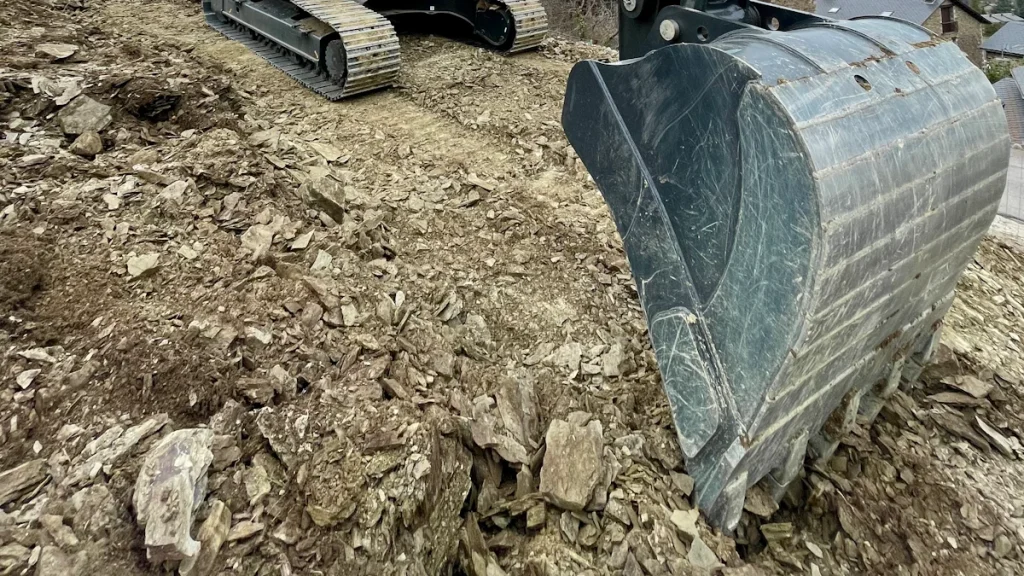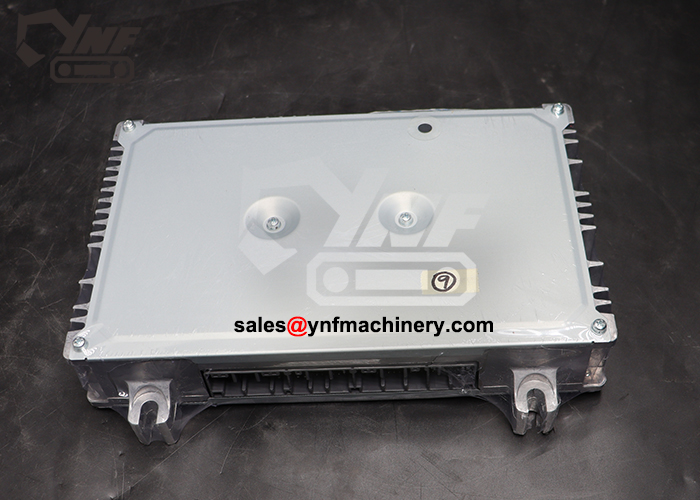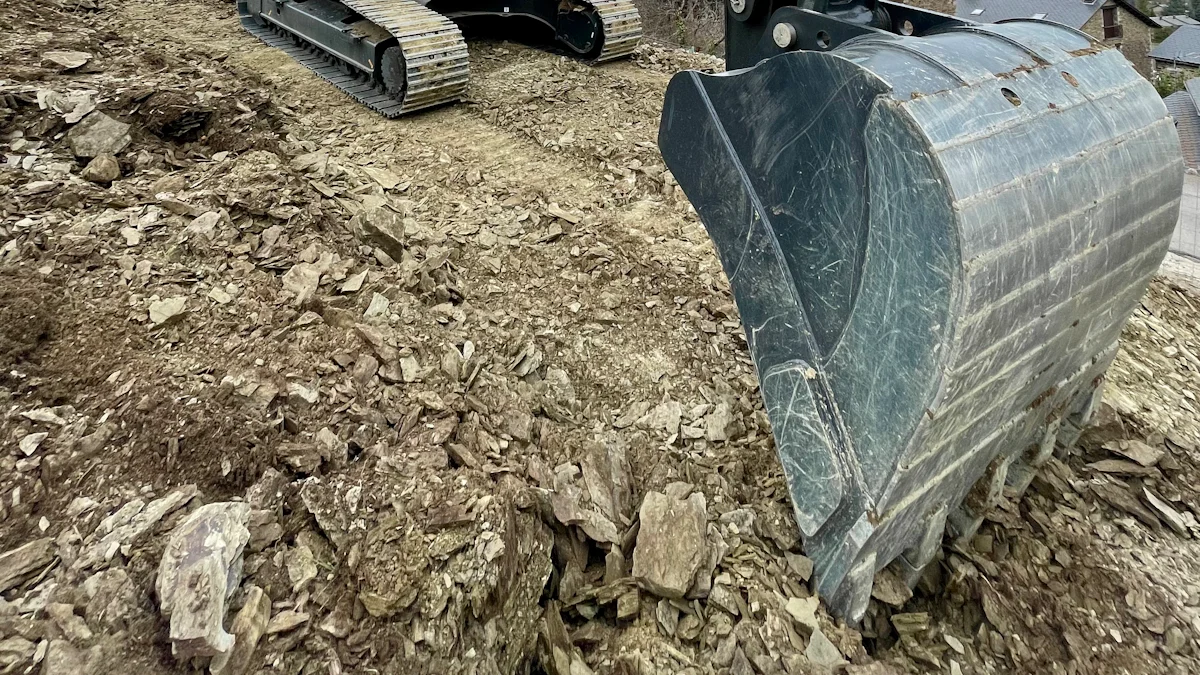
Heavy-duty machines like the John Deere 200 excavator work hard every day. Over time, some john deere 200 excavator parts wear out due to constant use. You’ve probably noticed how even the toughest equipment needs a little care now and then. Replacing commonly replaced parts on time keeps your excavator running smoothly and avoids costly breakdowns. Whether it’s a hydraulic hose or a track pad, staying ahead of wear and tear ensures your machine stays reliable and efficient.
Key Takeaways
Check your John Deere 200 excavator often to find small problems early. Pay attention to the hydraulic system, undercarriage, and engine to avoid expensive fixes.
Buy good replacement parts from trusted sellers like YNF Machinery. Good parts help your machine work better and break down less.
Take care of hydraulic hoses, cylinders, and pumps. Watch for leaks, strange noises, or damage, and replace them quickly to keep things running well.
Lubrication is very important to stop friction and damage. Use the right lubricants and grease moving parts every 50 to 100 hours of use.
Be active with maintenance plans. Keep track of hours used and plan regular check-ups to keep your excavator working safely and smoothly.
Hydraulic System Components in John Deere 200 Excavator Parts
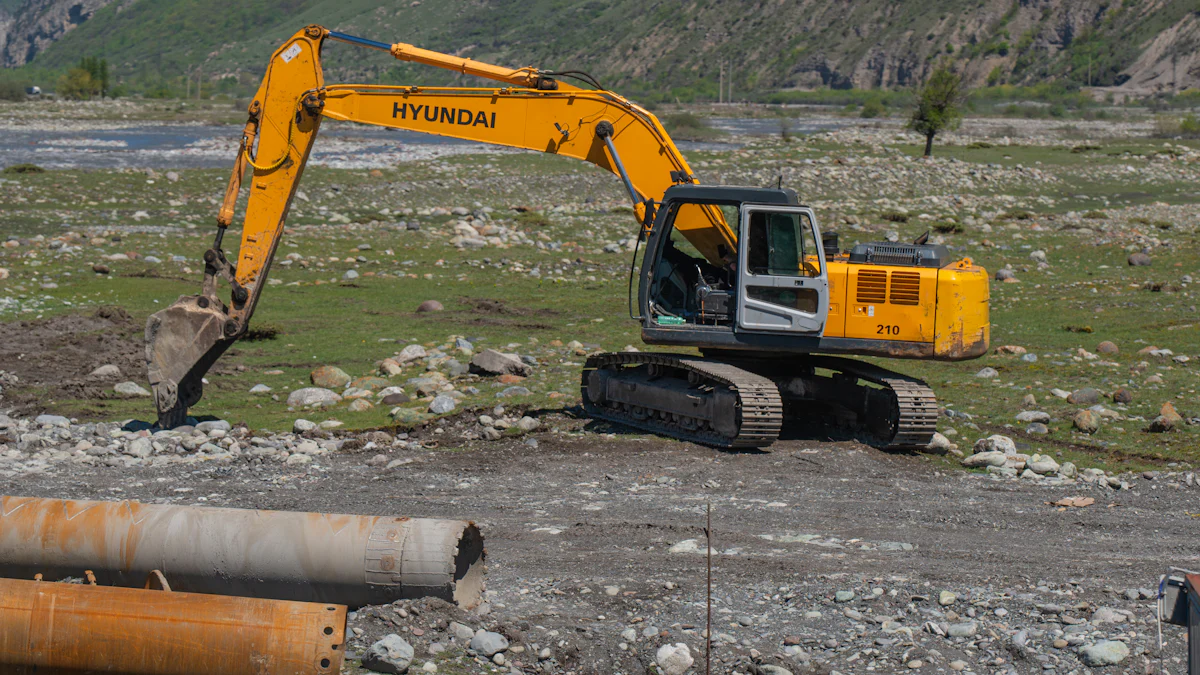
The hydraulic system in your John Deere 200 excavator is the backbone of its operation. It powers everything from the arm to the bucket, making it essential to keep these components in top shape. Let’s dive into three key parts that often need attention.
Hydraulic Hoses
Function and Importance
Hydraulic hoses carry pressurized fluid to different parts of your excavator, enabling smooth and powerful movements. Without them, your machine wouldn’t function.
Signs of Wear
You’ll want to watch for cracks, leaks, or bulges in the hoses. Abrasion, poor routing, and high temperatures are common culprits behind hose failures. Bent hoses or fluid incompatibility can also cause damage over time.
Replacement Tips
When replacing hoses, choose high-quality ones that match your machine’s specifications. Proper routing and securing can prevent future wear. Regularly inspect hoses for damage to catch issues early.
Hydraulic Cylinders
Function and Importance
Hydraulic cylinders convert fluid power into mechanical force, allowing your excavator to lift, dig, and move materials. They’re critical for heavy-duty tasks.
Signs of Wear
Look out for fluid leaks, slow or unresponsive movement, and unusual noises. Damaged seals, bent rods, or excessive heat are also red flags. Contamination can worsen these issues, so keep an eye on cleanliness.
Replacement Tips
Replace worn seals promptly to avoid further damage. Clean the cylinder and surrounding areas before installation. Using a high-quality seal kit, like those from YNF Machinery, ensures durability and reliability.
Hydraulic Pumps
Function and Importance
The hydraulic pump is the heart of your excavator’s hydraulic system. It generates the pressure needed to power the machine’s movements.
Signs of Wear
If you hear banging or knocking sounds, it could mean wear or air in the system. A weak final drive motor or temperatures above 82°C (180°F) are also signs of trouble.
Replacement Tips
Choose a pump that matches your excavator’s specifications. Regularly check fluid levels and replace filters to maintain pump health. High-quality John Deere parts can help extend the life of your hydraulic system.
By staying proactive with these commonly replaced parts, you’ll keep your John Deere 200 excavator running smoothly and avoid costly downtime.
Undercarriage and Common Excavator Parts
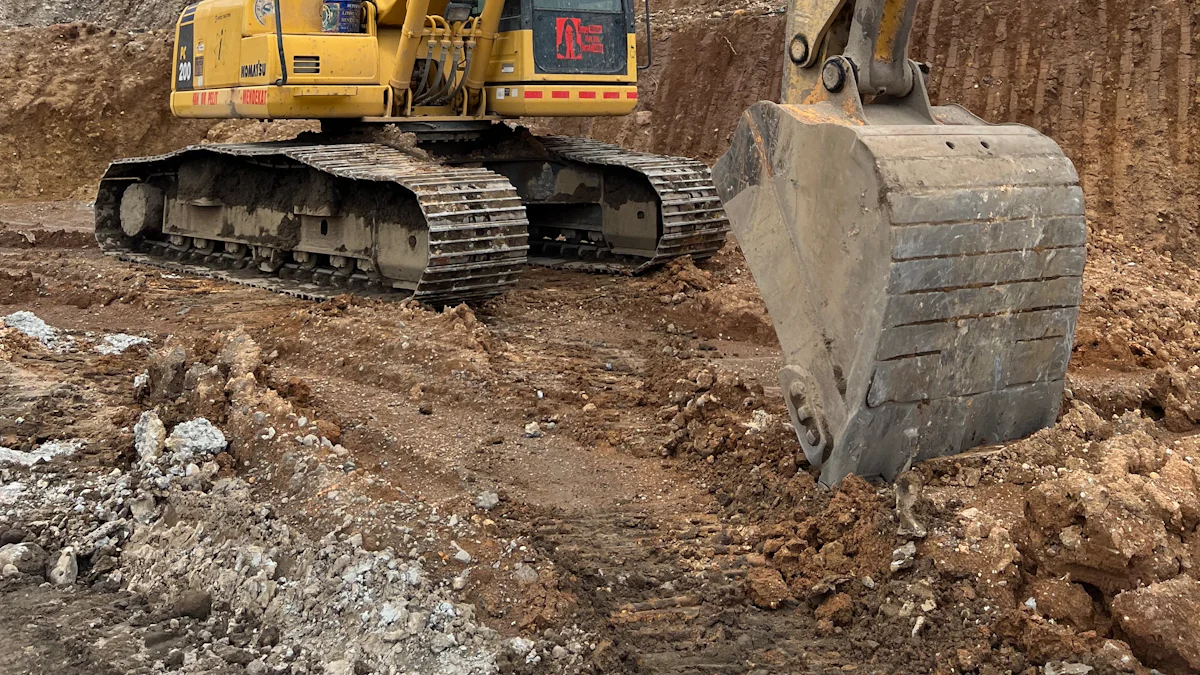
The undercarriage of your John Deere 200 excavator takes a beating every day. It supports the machine’s weight and ensures smooth movement across tough terrains. Let’s explore some of the most frequently replaced undercarriage components and how to keep them in top shape.
Tracks and Track Pads
Function and Importance
Tracks and track pads are essential for your excavator’s mobility. Tracks provide stability and traction, while track pads protect the tracks and improve grip on various surfaces. Together, they ensure your machine can handle rugged environments with ease.
Signs of Wear
You’ll want to inspect your tracks and pads regularly. Look for these signs:
Tearing or thinning of rubber tracks from sharp objects or pressure.
Drying out caused by UV exposure.
Visible steel parts, which indicate excessive wear.
Abrasion or thinning of rubber pads.
If you notice any of these, it’s time to act.
Replacement Tips
When replacing tracks or pads, choose high-quality options that match your machine’s specifications. Proper installation is key to avoiding premature wear. Regular cleaning and inspections can also extend their lifespan.
Rollers and Idlers
Function and Importance
Rollers and idlers guide and support the tracks, ensuring smooth operation. They distribute the machine’s weight evenly, reducing stress on the tracks and improving overall performance.
Signs of Wear
Pay attention to these warning signs:
Uneven wear caused by track misalignment.
Grinding or squeaking noises, which may indicate improper lubrication.
Visible damage from abrasive materials like sand or soil.
Replacement Tips
Keep rollers and idlers well-lubricated to prevent friction. Regularly check for misalignment and clean off debris. Replacing worn components promptly can save you from bigger issues down the line.
Sprockets
Function and Importance
Sprockets are the toothed wheels that drive the tracks. They play a crucial role in your excavator’s movement by transferring power from the engine to the tracks.
Signs of Wear
Worn sprockets can cause uneven track movement. Look for rounded or chipped teeth, which reduce their ability to grip the tracks. Excessive noise during operation is another red flag.
Replacement Tips
Replace sprockets as soon as you notice significant wear. Pairing new sprockets with worn tracks can lead to faster deterioration, so it’s best to replace both together. Regular maintenance and cleaning can help extend their lifespan.
By keeping these common excavator parts in good condition, you’ll ensure your machine stays reliable and efficient, even in the toughest conditions.
Engine and Cooling System Parts by YNF Machinery
Keeping your John Deere 200 excavator’s engine and cooling system in top shape is crucial for smooth operation. These components work hard to power your machine and prevent overheating. Let’s break down the key parts you should monitor and replace when needed.
Excavator Engine Parts
Function and Importance
The engine is the heart of your excavator. It generates the power needed to dig, lift, and move materials. High-quality engine parts ensure your machine runs efficiently, even under tough conditions.
Signs of Wear
You might notice reduced power, unusual noises, or excessive smoke from the exhaust. Difficulty starting the engine or increased fuel consumption are also red flags. These signs often point to worn-out components like injectors, pistons, or crankshafts.
Replacement Tips
When replacing engine parts, always choose components that meet or exceed OEM standards. YNF Machinery offers durable options designed to handle heavy-duty tasks. Regular maintenance, like changing filters and checking oil levels, can extend the life of your engine.
Radiators and Cooling Components
Function and Importance
Radiators and cooling components keep your excavator from overheating. They regulate engine temperature, ensuring optimal performance during long hours of operation.
Signs of Wear
Watch for these common issues:
Overheating, which may indicate a clogged or damaged radiator.
Coolant leaks, often visible as rainbow-colored puddles under your machine.
Unusual noises like hissing or bubbling, signaling potential problems.
Replacement Tips
Replace damaged radiators promptly to avoid engine damage. Clean the cooling system regularly to prevent blockages. YNF Machinery provides reliable cooling components that fit seamlessly with your John Deere parts.
Belts and Hoses
Function and Importance
Belts and hoses play a vital role in your excavator’s engine and cooling systems. Belts drive essential components like the alternator, while hoses transport fluids like coolant and oil.
Signs of Wear
Here’s what to look for:
Belts: Visible cracks, squeaking noises, or reduced power output. A broken serpentine belt can even cause a complete shutdown.
Hoses: Damage from vibration, improper installation, or regular wear. Issues like overheating, coolant leaks, or engine misfires often stem from faulty hoses.
Replacement Tips
Inspect belts and hoses regularly for signs of wear. Replace them with high-quality options to avoid unexpected breakdowns. YNF Machinery offers durable excavator parts and accessories that ensure long-lasting performance.
By staying on top of these engine and cooling system components, you’ll keep your John Deere 200 excavator running efficiently and avoid costly repairs.
Electrical Components in John Deere 200 Excavator Parts
Electrical components in your John Deere 200 excavator play a vital role in keeping the machine operational and safe. From powering the engine to ensuring visibility, these parts need regular attention to avoid unexpected failures. Let’s explore the key electrical components you should monitor.
Batteries
Function and Importance
Your excavator’s battery provides the electrical power needed to start the engine and operate various systems. It’s the lifeline for all electrical functions, ensuring smooth operation.
Signs of Wear
A failing battery can cause several issues. You might notice the engine struggling to start or find that the battery is completely dead. Electrical problems, like faulty wiring, can also lead to battery failure.
Replacement Tips
When replacing the battery, choose one that matches your machine’s specifications. Regularly check the terminals for corrosion and ensure the connections are secure. Keeping the battery charged and clean can extend its lifespan.
Wiring and Connectors
Function and Importance
Wiring and connectors distribute power throughout your excavator, linking various electrical components. They ensure everything from lights to sensors functions properly.
Signs of Wear
Here’s what to watch for:
Electrical malfunctions, like flickering lights or power loss.
Short circuits, often indicated by blown fuses.
Physical damage, such as frayed wires or melted insulation.
Corrosion or moisture damage, visible as rust or a greenish tint.
Diagnostic trouble codes (DTCs) related to wiring issues.
Replacement Tips
Inspect wiring and connectors regularly. Replace damaged wires promptly to prevent further issues. Use high-quality John Deere parts to ensure reliability. Keeping the wiring harness clean and dry can also reduce wear.
Lights and Indicators
Function and Importance
Lights and indicators are essential for safe operation, especially in low-light conditions. They help you see clearly and signal your presence to others on the site.
Signs of Wear
Common issues include:
Non-functional lights, which compromise safety.
Dim or flickering lights, often caused by electrical problems.
Broken or missing indicators, which can lead to operational hazards.
Replacement Tips
Test all lights and indicators regularly. Replace faulty components immediately to maintain safety. Proper lighting ensures smooth operation, even in challenging environments. YNF Machinery offers durable options that fit seamlessly with your John Deere 200 excavator parts.
By keeping these electrical components in good condition, you’ll ensure your excavator operates efficiently and safely, no matter the conditions.
Maintenance Tips for Longevity with YNF Machinery
Keeping your John Deere 200 excavator in top condition doesn’t have to be complicated. With a few simple maintenance habits, you can extend its lifespan and avoid costly repairs. Let’s explore some practical tips to keep your machine running smoothly.
Regular Inspections
Importance of Routine Checks
Routine inspections are your first line of defense against unexpected breakdowns. By catching small issues early, you can prevent them from turning into major problems. Regular checks also ensure your excavator operates safely and efficiently, saving you time and money in the long run.
Key Areas to Inspect
Here’s a quick checklist to guide your inspections:
Exterior Inspection: Look for visible damage on tracks, undercarriage, and hydraulic hoses.
Engine and Fluid Levels: Check oil, coolant, and fuel levels to ensure they’re within the recommended range.
Hydraulic System: Inspect cylinders, seals, and hoses for leaks or wear.
Controls and Cabin: Test control levers and safety features for proper functionality.
Bucket and Attachments: Examine teeth, cutting edges, and attachment pins for wear or damage.
By inspecting these areas regularly, you’ll keep your machine in peak condition.
Proper Lubrication
Importance of Lubrication
Lubrication is essential for reducing friction and wear on moving parts. It keeps your excavator running smoothly and prevents costly damage. Neglecting lubrication can lead to overheating, increased wear, and even part failure.
Recommended Lubricants
For the best results, use lubricants specifically designed for your machine. John Deere Hy-Gard oil and John Deere Hitachi Excavator Hydraulic Fluid are excellent choices. These products ensure optimal performance and protect your machine’s components from wear and tear. Make it a habit to lubricate joints and bearings every 50 to 100 operating hours.
Using Quality Replacement Parts
Benefits of YNF Machinery Parts
High-quality replacement parts make a big difference in your excavator’s performance. They’re durable, reliable, and designed to fit perfectly with your machine. YNF Machinery offers premium parts that reduce downtime, improve efficiency, and even lower fuel consumption. By choosing quality parts, you’ll save money on repairs and enjoy peace of mind knowing your machine is in good hands.
Risks of Using Substandard Parts
Using cheap or counterfeit parts might seem like a good idea at first, but it can lead to serious problems. Here’s why:
Risk Type | Description |
|---|---|
Reduced Performance | Substandard parts often lack precision, leading to inefficiency. |
Increased Downtime | Inferior parts fail more often, causing unexpected breakdowns. |
Safety Hazards | Counterfeit parts can compromise safety, increasing the risk of accidents. |
Long-Term Damage | Poor-quality parts can damage your machine, leading to costly repairs. |
Environmental Impact | Low-grade parts may leak fluids or produce higher emissions. |
Investing in high-quality John Deere parts from YNF Machinery ensures your machine stays reliable and safe.
By following these maintenance tips, you’ll keep your John Deere 200 excavator running like new for years to come.
Keeping your John Deere 200 excavator in top shape doesn’t have to be a challenge. Regular maintenance and timely replacement of worn parts are key to ensuring your machine runs efficiently. By focusing on commonly replaced john deere 200 excavator parts and using high-quality components from trusted suppliers like YNF Machinery, you can extend your equipment’s lifespan and reduce costly repairs.
Proactive maintenance strategies, like tracking operating hours and scheduling downtime for inspections, help you stay ahead of potential issues. Preventive care not only minimizes downtime but also boosts performance and safety. Investing in quality parts and consistent upkeep ensures your excavator remains a reliable workhorse for years to come.
️ Tip: Utilize diagnostic tools to catch problems early and prioritize repairs. This approach saves time and keeps your operations running smoothly.
FAQ
1. How often should I inspect my John Deere 200 excavator?
You should inspect your excavator daily before use. Focus on critical areas like the hydraulic system, undercarriage, and engine. Regular checks help you catch small issues early and avoid costly repairs.
️ Tip: Create a checklist to make inspections quick and thorough.
2. What’s the best way to extend the life of hydraulic hoses?
Keep them clean and properly routed. Inspect for cracks or leaks regularly. Replace worn hoses with high-quality options like those from YNF Machinery. Proper maintenance ensures smooth operation and prevents unexpected failures.
3. Can I use aftermarket parts for my John Deere 200 excavator?
Yes, but choose parts that meet or exceed OEM standards. YNF Machinery offers durable aftermarket options designed for compatibility and performance. Using high-quality parts ensures reliability and reduces downtime.
4. How do I know when to replace my excavator’s tracks?
Look for signs like thinning rubber, exposed steel, or reduced traction. If your machine struggles to move smoothly, it’s time to replace the tracks. Regular cleaning and inspections can help you spot wear early.
5. Why is proper lubrication so important?
Lubrication reduces friction and prevents wear on moving parts. It keeps your excavator running efficiently and avoids overheating. Use recommended lubricants and follow a regular schedule to maximize your machine’s lifespan.
Note: Neglecting lubrication can lead to costly damage and downtime.

